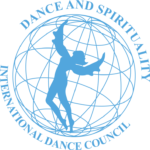Morocco
Dance in Morocco is not only a form of artistic expression, but it also plays a crucial role in celebrating rites of passage, from religious holidays to weddings. Each region, whether mountainous, desert or coastal, has its own dance styles that reflect its unique cultural heritage.
Moroccan dances are often associated with specific ceremonies and social events. For example, the Ahidous dance is typically performed during agricultural festivals in the Atlas Mountains, while the Guedra is a desert ritual dance often associated with spiritual ceremonies. These dances are not just entertainment, but integral elements of Moroccan culture that reinforce the sense of community and belonging.
The diversity of communities in Morocco, including Berbers, Arabs and Sahrawis, contributes to an array of dances that are as varied as the country’s landscapes. Each community brings its own nuances, making each dance unique while sharing common themes of joy, spirituality and community.
Author : Mona Loew
List Of Dances
Aarfa
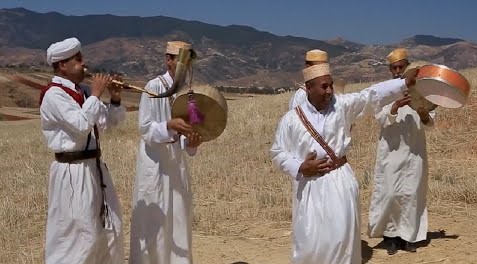
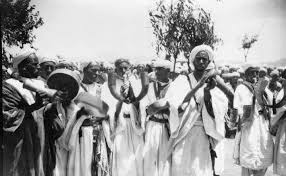
La Aarfa aussi appelé Ach-chyoukh, (en Berbère : Imedyazen, « Les troubadours ») est une danse guerrière originaire du Rif. La Aarfa, danse guerrière rifaine a donné naissance à la musique reggada.
Les troupes de Aarfa sont composées d’un meneur appelé cheikh, de joueurs de flûte et de joueurs de bendir. Le cheikh dans son rôle de meneur, dicte le tempo, chante et fait aussi les dédicaces. On dit alors qu’il barrah (arabe) ou itragha (berbère). Autrefois, les troupes d’Imedyazen étaient accompagnés par des guerriers (Ibaroudiyen en berbère) qui tiraient une salve de poudre selon les ordres du cheikh. Cette pratique a aujourd’hui disparu.
Il existe quatre répertoires principaux pour les Imdiazen, qui ont été quelque peu influencés par la prosodie arabe
- Izran : Le cheikh chante des vers en berbère, appelés Izran. Ceux-ci sont entrecoupés par un refrain appelé Aya ralla buya ;
- Lġiwan : Il s’agit d’un style de prose typique des tribus Bni Iznassen, Bni Bouyahyi ou encore Mtalsa chanté le plus souvent en arabe ;
- Laarour : Poème satirique rifain ;
- Aya moulay negh : Il s’agit d’une prose uniquement chantée lors de la Tameghra (mariage) en l’honneur du marié.
Il existe encore des Mechyakha (troupe de cheikh) chez les Beni Touzine, les Temsaman, les Igzennayen et les Guelaya. Mais c’est sans conteste les tribus des Beni Iznassen qui ont su le plus sauvegarder ce folklore, et qui possède aujourd’hui le plus grand nombre de cheikhs. Berkane est aujourd’hui considéré comme étant la capitale de la Aarfa. La Aarfa s’est aujourd’hui diffusée dans d’autres villes de l’Oriental comme Oujda ou Jerada alors qu’elle n’y était pas présente à l’origine.
Reference : Wikipedia “Read”
MOROCCO
Region: Rif
Ethnic group: Rifaines
La Aarfa a inspiré le style Reggada qui s’est répandu depuis les provinces de Nador, Driouch et Berkane dans les provinces de Oujda, Taourirt, Al Hoceima, Taza, Guercif et dans le nord-ouest algérien
Ahidous
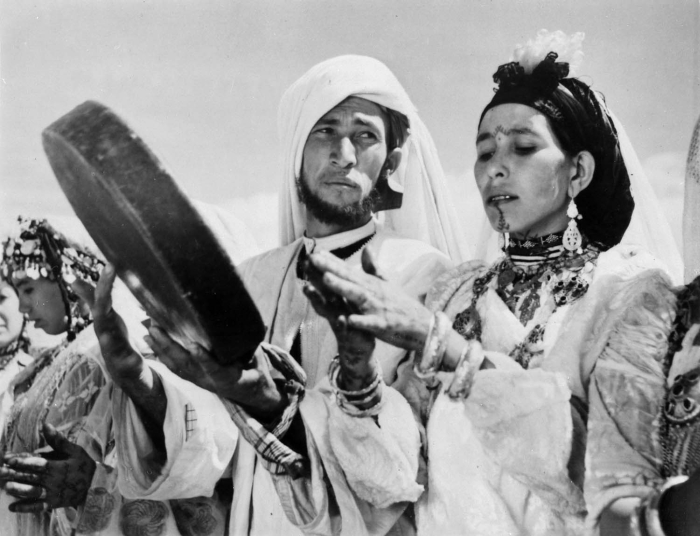
Credit : Wikicamp Morocco 2023
L’Ahidouss est une danse collective amazighe ancestrale que l’on retrouve dans différentes régions du Maroc, qui est indissociable du chant et de la musique au rythme du Bendir (tambour marocain) et de battements de mains. Épaules contre épaules, les membres d’une même tribu expriment leur joie, leurs peines, leur opinion autour d’un symbole commun : la nature. Des joutes oratoires peuvent être improvisées sous forme de questions / réponses. On retrouve différentes formes de Ahidouss aux quatre coins du Maroc, chacune basée sur ses propres codes et rituels.
Author : Raïssa Leï
See her Presentation in CID’s Online Seminar « Transmission du geste rituel » |29 mai 2021 |
Additional Reference : Wikipedia “Read”
MOROCCO
Region: Toutes
Ethnic group: Amazighs
(Les Imazighen ou Amazighs, plus connus sous le nom de Berbères)
Ahouach
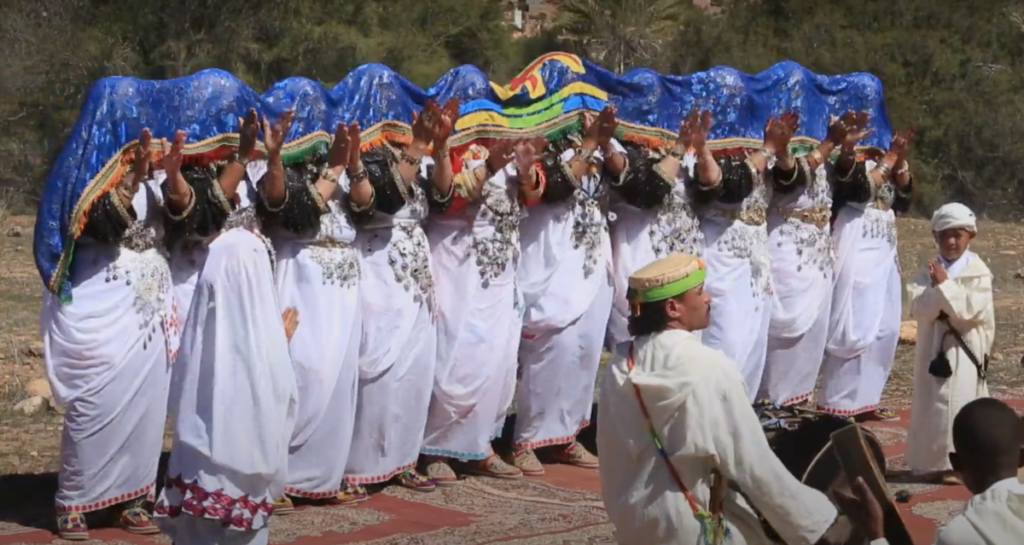
La danse ahouach est une pratique rituelle qui met en acte une symbolique des rapports entre les différents actants qui y participent par l’entremise de structures chorégraphiques collectives.
La séance peut durer jusqu’à deux heures de danse dont le dialogue de poésie entre les participants. C’est pourquoi la qualité de la danse d’ahouach dépend de la qualité de la poésie et de son authenticité
Parmi les instruments qui sont utilisés pendant la danse, on note le tara (une sorte de tambourin), le tbel (tambour), le naqus (instrument en métal sur lequel on frappe au moyen de deux bâtons en fer).
Reference : Wikipedia “Read”
MOROCCO
Region: Sud
Ethnic group: Berberes
Aïssawa
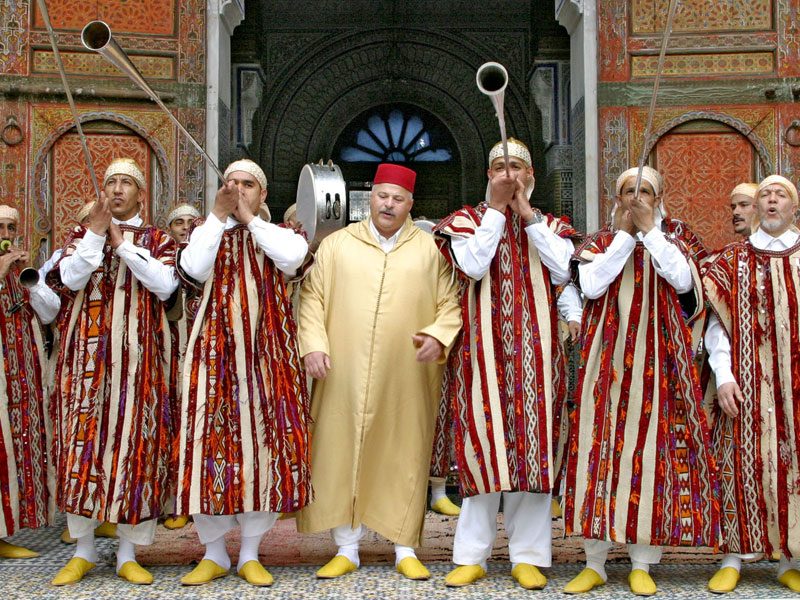
The brotherhood of Aïssawa is a mystico-religious order founded in Meknes in Morocco by Muhammad ben Aïssâ (1465-1526) nicknamed the “Perfect Master”
The reasons for organizing a ceremony are diverse: celebration of a Muslim holiday, marriage, birth, circumcision, exorcism, search for healing or contact with the divine through ecstasy.
The ritual is offered identically by all the Aïssâwa orchestras and includes recitations of mystical litanies, songs of spiritual poems, an exorcism ritual and a collective trance dance session. The fun aspects of the ceremony are common and claimed by the participants (laughs, songs, dances) as well as the ecstatic bodily manifestations (shouts, crying).
The experience crosses both the world of men and that of demons to culminate in the higher spheres, the meeting point of man and the divine.
The trance ritual practiced by the Aïssâwa today seems to have been established over the centuries under the triple influence of original Sufism, pre-Islamic animist beliefs and urban Arab poetry, like the Melhoun.
Reference : Radio France “Read”
MOROCCO
Region: Meknes
Ethnic group:
brotherhood of Aïssawa
Founded in Meknes and spread all over Morocco
Gnaoua

Gnawa refers to a set of musical events, performances, fraternal practices and therapeutic rituals mixing the secular with the sacred. Gnawa is first and foremost a Sufi brotherhood music combined with lyrics with a generally religious content, invoking ancestors and spirits.
Originally practised by groups and individuals from slavery and the slave trade dating back to at least the 16th century, Gnawa culture is now considered as part of Morocco’s multifaceted culture and identity. The Gnawa, especially in the city, practise a therapeutic possession ritual through all-night rhythm and trance ceremonies combining ancestral African practices, Arab-Muslim influences and native Berber cultural performances.
The Gnawa in rural areas organize communal meals offered to marabout saints. Some Gnawa in urban areas use a stringed musical instrument and castanets, while those in rural areas use large drums and castanets. Colourful, embroidered costumes are worn in the city, while white attire with accessories characterize rural practices.
The number of fraternal groups and master musicians is constantly growing in Morocco’s villages and major cities, and Gnawa groups – organized into associations – hold local, regional, national and international festivals year-round. This allows young people to learn about both the lyrics and musical instruments as well as practices and rituals related to Gnawa culture generally.
Gnaoua is inscribed on UNESCO’s representative list of the intangible cultural heritage of humanity in December 2019
Reference : UNESCO read
MOROCCO
Region: all
Ethnic group:
Sufi brotherhoods
Rituals akin to the Gnaoua of Morocco also exist in Tunisia and in eastern Algeria (called Stambali and Benga), in Egypt (called Zār), and in Algeria except in the east (called Diwan or Bori Haoussa ) and in the Fezzan of Libya (Stambali)
Guedra
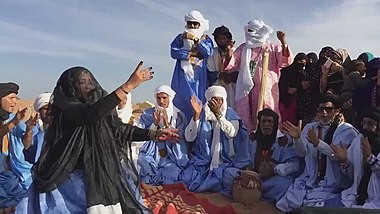
The Guedra dance takes place in a circular space with a dancer in the middle. A space that the people of the desert call “Gara”, whose verbal derivation goes back to the Latin term “Agora”, which means circular shape.
It is a group dance open to all, where everyone is invited to be part of the circle which can shrink or expand depending on the number of participants in this folk dance.
The group of singers is made up of several men forming a circle, at their head a musician who performs a regular rhythm throughout the dance by striking a pottery drum, called the Guedra, hence the name given to this dance.
After a few minutes, a veiled and draped woman joins the center of the circle and kneels before showing off her hands decorated with henna. After settling in, alone or accompanied by a second dancer, she begins to perform her choreography, gracefully, while remaining seated.
Reference : Wikipedia read
MOROCCO
Region: South
Ethnic group:
Saharan tribes, particularly in Guelmim-Oued Noun region
It also exists in some northern saharan regions ( M’Hamid El Ghizlane and Tata) where it is called Chemra
Halka
 Halqa is an art of Moroccan acrobatics inherited from Sufism.
Halqa is an art of Moroccan acrobatics inherited from Sufism.
This ancestral tradition was born in the 15th century in the brotherhood of the Sufi sage Sidi Ahmed Ou Moussa, defender of these artists. At the time, combatants of a particular kind gathered around him. Capable of climbing on top of each other in vertiginous human pyramids, these warriors were recruited to cross the enemy walls before being later used to identify, in the desert, foreign caravans or possible dangers .
Since then The tradition was perpetuated by families till now like a Tanger group founded by Sana El Kamouni.It is a spiritual art which is danced, sung accompanied by percussion, and not just a technical feat. It has also a poetic dimension as
to each figure corresponds a Berber word, like Maâcuda which can be translated as “the jump of the gazelle in the desert”. Before being technical, each figure is first of all poetic, charged with a story.
Reference : Groupe acrobatique de Tanger Read
MOROCCO
Region: all
Ethnic group:
brotherhood which tradition is perpetuated by families till now
